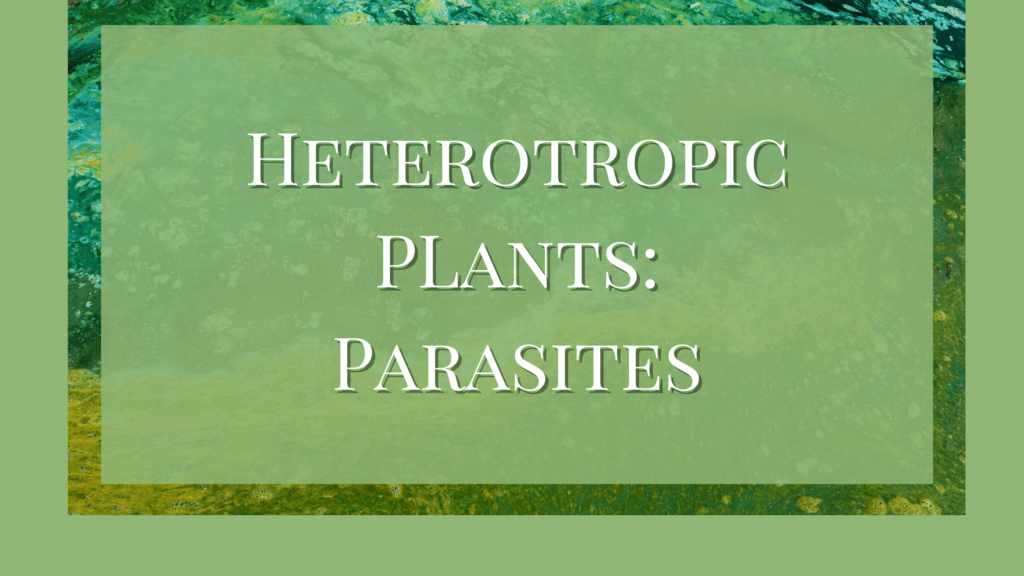The majority of plants are capable of synthesizing their own organic food owing to the presence of chlorophyll (autotrophic). But quite a number of plants are incapable of food production to meet their nutritional requirements. Eg., Fungi, the majority of bacteria, and some higher plants. They are collectively called heterotrophic plants or heterophytes.
All life forms that obtain their food from other living organisms are called parasites. The plant or animal that supplies the food is called a host.
What are Parasitic Plants?
So what are parasitic plants? Parasitic plants are those plants that depend completely on the plants for their food and nutrition. They are called complete parasites or total parasites. E.g.. Cuscuta. Some parasites derive food only partially from their host and are called partial parasites, semi-parasites, or incomplete parasites. Eg. Loranthus.
Parasitism is common among fungi and bacteria. In the case of fungi, mycelium penetrates the host tissue by dissolving cell wall materials with the help of enzymes. In some cases, the mycelium enters the living cell and sends special food-absorbing structures called haustoria into the cells.
Due to parasitism fungi and bacteria cause many diseases in plants and animals that host them. Such disease-causing organisms are called pathogens. Eg. Citrus Canker by Xanthomonas citri, rust and must fungi, etc. Many parasitic fungi cause diseases in apples, tomatoes, etc.
Algae- Cephaleuros causes red disease in tea and pepper. In flowering plants, some parasites may grow on stems or roots. These are called stem and root parasites respectively. Some of them are total parasites while others are partial parasites.
Stem Parasites
Complete Stem Parasites
Many angiosperm parasites are found to live on the stems of their host plants. Among them, Cuscuta is a common example of total or complete stem parasites that grow on herbs, shrubs, and trees.
Cuscuta is a small turner that turns around the branches of the host plant. It is devoid of chloroplast and does not perform photosynthesis. It is completely dependent on the host plant and hence forms an example of a total stem parasite.
Mode of nutrition in parasitic plants
Its stem is yellow which contains small scales or leaves that are brown in color. From different regions of the stem, there are sucking roots called haustoria arise, that penetrate the host. This haustorium will then absorb food from the host. The xylem and phloem of each haustoria get attached to the xylem and phloem of the host plant so that the parasite can absorb both raw and prepared food.
Reproduction in Cuscuta
These parasites produce flowers and fruits. The seeds will germinate in the soil and young seedlings will be formed. The apex of the seedling attaches to the ground and the free portion moves around spirally until it gets attached to a host. It then twines around the host like a tendril and it develops several haustoria.
Later when the plant is safely attached to the host, its lower part dies out. If there are no hosts available for the seedling, it perishes.
Partial Stem Parasites
Plants like Loranthus and Viscum absorb only water and minerals from their host. They develop normal green leaves and synthesize carbohydrates. They depend on the host only for a portion of their food.
Such plants are called partial stem parasites. The partial stem parasite grows only on stems and branches.
These two plants resemble each other in their mode of nutrition and dispersal. They produce berry-type fruits with a sticky pulp. These are eaten by birds and due to the stickiness of seeds, they remain attached to the beak of birds. When the birds rub their beaks on tree branches to get rid of them, the seeds get attached to those branches.
These attached seeds will germinate to produce root-like structures called haustorium. The haustorium penetrates the host stem and absorbs water and minerals as needed.
Another example of this type of parasite is Cassitcha filiformis. It is often regarded as a total parasite but it develops chlorophyll in its stem. So it can perform photosynthesis and thus is a partial stem parasite.
Root Parasites
Certain plants absorb food from the roots of the host and form the root parasite. Such common parasites are Balanophore, Orobanche, Rafflesia, Striga, etc. Balanophora grows on the roots of Solanum, tobacco, etc., and Striga grows usually on the roots of sugarcane. The Rafflesia plant is unique and is found in Burma, Sumatra, etc.
Its vegetative body is completely underground and its branches form fungus-like threads which absorb food from the host root. It produces the biggest flower in the plant kingdom measuring about a yard in diameter. This flower forms the only recognizable part of the plant.
Because of the total parasitic habit, all these plants do not develop chlorophyll. They produce haustoria which absorbs both inorganic and organic food from the roots of the host.
So morphologically all these plants show an extreme reduction in their vegetative body. Very rarely are the scale leaves formed. The specialization of parasitism reaches the climax in the case of Rafflesia when the vegetative body becomes fungus-like.
Physiologically these plants are very peculiar owing to the absence of chlorophyll, photosynthesis is absent. Transpiration is at a very low rate.
Some of the root parasites such as Sandalum album are partial root parasites. The roots of this plant develop haustoria which gets attached to the roots of neighbouring host plants. If suitable hosts are not present, the plant turns pale color and is incapable of growing beyond a year. It absorbs only raw materials as the plants are green and are capable of photosynthesis.
References
https://www.nhm.ac.uk/discover/parasitic-plants.html




